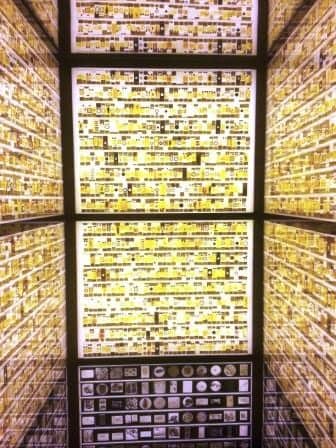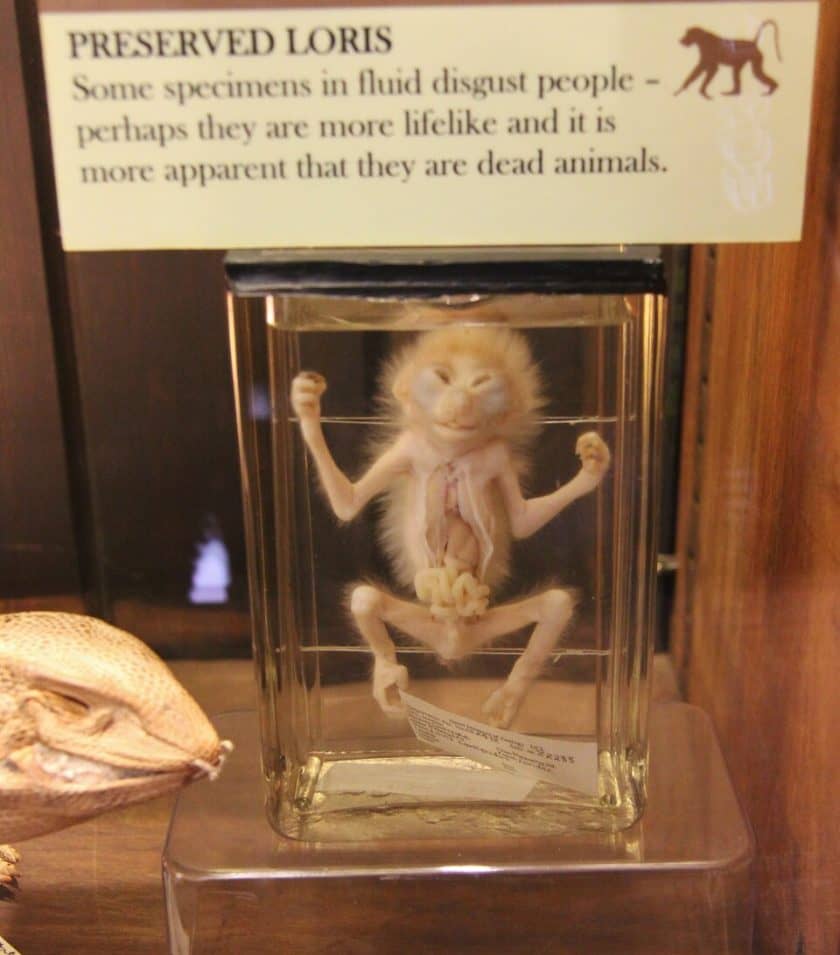Grant Museum of Zoology London
A free, historic London museum housing 68,000 zoological specimens, from extinct animals to the 'jar of moles'.

Highlights
Must-see attractions

Social
From TikTok & Reddit
Best Time
Fewer crowds, more space to explore
Grant Museum of Zoology London
Best Time
Fewer crowds, more space to explore

Highlights
Must-see attractions
A free, historic London museum housing 68,000 zoological specimens, from extinct animals to the 'jar of moles'.
"A hidden gem in London that perfectly captures the charm of Victorian scientific curiosity."
🎯 Free Entry, Plan Ahead
Admission is free! But check opening times as it's not always open. Arrive early to beat crowds.
👟 Comfortable Shoes Recommended
It's a compact museum, but you'll be on your feet exploring all the specimens.
Highlights
Discover the most iconic attractions and experiences

The Jar of Moles
Main Hall
A surprisingly captivating display of moles, arranged in a unique and memorable way. A true conversation starter!

Rare Skeletons
Various Displays
Marvel at the skeleton of a quagga, one of only seven in the world, and discover bones from the extinct dodo bird.

The Micrarium
Dedicated Cupboard
Explore over 2,000 lantern slides showcasing the planet's tiniest specimens, from insect wings to a 2mm squid.

Preserved Specimens
Throughout the Museum
Gaze at a vast collection of preserved animals, organs, and embryos, offering a glimpse into the diversity of life.
Plans like a pro.
Thinks like you
Planning Your Visit
Free Entry, Big Impact
A Victorian Cabinet of Curiosities
Best Times
Insider Tips
from TikTok, Instagram & Reddit
🎯 Free Entry, Plan Ahead
Admission is free! But check opening times as it's not always open. Arrive early to beat crowds.
👟 Comfortable Shoes Recommended
It's a compact museum, but you'll be on your feet exploring all the specimens.
📱 Great for Curious Minds
Perfect for anyone interested in zoology, biology, or the wonderfully weird.
📸 Photography Friendly
Capture the unique displays, but be mindful of other visitors in the tight spaces.
Tips
from all over the internet
🎯 Free Entry, Plan Ahead
Admission is free! But check opening times as it's not always open. Arrive early to beat crowds.
👟 Comfortable Shoes Recommended
It's a compact museum, but you'll be on your feet exploring all the specimens.
📱 Great for Curious Minds
Perfect for anyone interested in zoology, biology, or the wonderfully weird.
📸 Photography Friendly
Capture the unique displays, but be mindful of other visitors in the tight spaces.
🧒 Kid-Friendly Activities
Look out for games and coloring activities designed to engage younger visitors.
What Travellers Say
Reviews Summary
Visitors consistently praise the Grant Museum of Zoology as a fascinating and unique hidden gem in London, offering a charming Victorian cabinet of curiosities experience. Its free entry and extensive collection of specimens, including rare extinct animals, are major draws. Some find it compact and potentially crowded, especially with school groups, and recommend checking opening times.
"The 'World of Wasps' exhibit offered an engaging and interactive experience that sparked the children's curiosity and deepened their understanding of wasps.
The museum featured a diverse collection of taxidermied animals, providing valuable insights into the practice of animal preservation and its educational purpose. With its calm and intimate atmosphere, the museum created a welcoming space for families to explore and learn together."
Journaling at Home
"An intriguing zoological museum. Very small and compact but with thousands of weird and wonderful exhibits including preserved organs, skeletons and remains from living and extinct animals. It has the feeling of an old Victorian scientific curiosity shop."
Andrau
"The Grant Museum of Zoology is a hidden gem in London that perfectly captures the charm of Victorian scientific curiosity.
Founded in 1828 by Robert Edmond Grant, it’s one of the UK’s oldest natural history collections and feels like stepping into a 19th-century cabinet of curiosities.
The museum has a charming antiquated vibe with wooden display cases, handwritten labels, and a sense of timeless discovery. The collection is surprisingly vast including intricate butterflies, preserved animals and their organs in jars, taxidermy animals and delicate nests to full animal skeletons.
A must visit for anyone with an interest in nature, history, or the beautifully curious."
Louise Watson
What People Like
What People Dislike
Frequently Asked Questions
🚇 🗺️ Getting There
The Grant Museum of Zoology is conveniently located in central London, a short walk from Warren Street tube station. Several bus routes also serve the area. It's easily accessible for a day trip or as part of a wider London exploration.
On-street parking in this central London area can be very limited and expensive. It's highly recommended to use public transport to reach the museum. The nearest tube stations are Warren Street and Euston Square.
The museum is quite compact, and while staff are helpful, navigating with a large stroller might be challenging due to the narrow aisles and display cases. Consider a baby carrier if possible.
The museum is on one floor, which aids accessibility. However, due to its historic nature and compact layout, some areas might be tight. It's advisable to contact the museum directly for specific accessibility details.
The closest Underground stations are Warren Street (Northern and Victoria lines) and Euston Square (Circle, Hammersmith & City, and Metropolitan lines). Numerous bus routes also stop nearby.
🎫 🎫 Tickets & Entry
No, entry to the Grant Museum of Zoology is completely free! This makes it an excellent option for budget travelers and families looking for affordable London attractions.
You cannot book tickets in advance as entry is free and on a first-come, first-served basis. It's best to check their opening hours before your visit as they can vary.
Opening hours can vary, and the museum is not open every day. It's essential to check the official UCL Grant Museum of Zoology website for the most up-to-date opening times before planning your visit.
The Grant Museum of Zoology offers free admission to all visitors, making it a highly accessible and popular attraction for those exploring London.
The museum occasionally hosts special exhibitions and events, such as drawing workshops. Keep an eye on their website and social media for announcements.
🎫 🧭 Onsite Experience
The museum houses over 68,000 specimens, including skeletons of extinct animals like the quagga and dodo, preserved organs, taxidermy, insects, and the famous 'jar of moles'. It's a fascinating collection for anyone interested in zoology and natural history.
Yes, the museum is very engaging for children, with its unique specimens and sometimes macabre displays sparking curiosity. They also offer games and coloring activities.
Given its compact size, a visit typically takes about 1-2 hours, depending on your level of interest and how busy it is. You can easily spend longer if you're deeply engrossed in the exhibits.
Photography is generally allowed for personal use, but it's always good practice to check for any specific signage or ask staff. Be mindful of flash photography and other visitors.
The Micrarium is a unique display featuring over 2,000 lantern slides dedicated to tiny specimens, highlighting that 95% of known animal species are smaller than your thumb.
🍽️ 🍽️ Food & Dining
The Grant Museum of Zoology is a museum and does not have its own cafe or restaurant facilities. You'll need to find dining options in the surrounding Bloomsbury or Fitzrovia areas.
The museum is located in a vibrant part of London with numerous cafes, pubs, and restaurants catering to various tastes and budgets. Explore the streets around UCL for plenty of choices.
Typically, museums discourage eating and drinking inside exhibit areas to preserve the specimens. It's best to consume any food or beverages outside the museum.
📸 📸 Photography
Yes, photography for personal use is generally permitted inside the Grant Museum of Zoology. It's a fantastic place to capture unique and intriguing images of zoological specimens.
While photography is allowed, avoid using flash as it can damage delicate specimens over time and disturb other visitors. Always be considerate of others' space and experience.
The 'jar of moles', the quagga skeleton, preserved organs in jars, and the intricate displays in the Micrarium are particularly photogenic. The overall Victorian cabinet of curiosities aesthetic also makes for great shots.
Tripods might be restricted due to the museum's compact layout and the need to maintain clear pathways. It's advisable to check with museum staff upon arrival if you plan to use one.
Check out Instagram and TikTok for inspiration! Creators often share their favorite shots, highlighting the most visually striking exhibits and unique angles.
For Different Travelers
Tailored advice for your travel style
👨👩👧 Families with Kids
While the museum is educational, some specimens might be a bit macabre for very sensitive children. It's a good idea to gauge your child's comfort level beforehand. The museum's free entry makes it an ideal choice for a spontaneous family adventure or a budget-friendly day out in London.
💰 Budget Travelers
Combine your visit with other free London attractions, like nearby museums or parks, to create a full day of exploration without breaking the bank. Remember to check opening hours as they can be limited, and consider packing your own snacks and drinks to save on food costs.
🔬 Science & Nature Enthusiasts
As an active university museum, the Grant Museum provides a unique opportunity to see specimens used for ongoing research and teaching. This adds an extra layer of authenticity and scientific relevance to your visit. Don't miss the Micrarium for a deep dive into the world of tiny creatures.
Deep Dives
In-depth insights and expert knowledge
A Glimpse into Zoological History
The collection boasts over 68,000 specimens, ranging from the minuscule to the monumental. Visitors can marvel at the skeletons of extinct animals, including the rare quagga and dodo bones, offering a tangible connection to species lost to time. Beyond skeletons, the museum houses an extensive array of preserved animals, organs, insects, and nests, providing a comprehensive overview of the animal kingdom. This makes it an invaluable resource for students and a fascinating destination for anyone interested in biology, natural history, or the sheer wonder of the natural world.
Beyond its historical significance, the Grant Museum continues to be an active part of UCL, used for teaching and research. This ensures that the specimens are not just relics of the past but are actively contributing to our understanding of zoology. The museum's commitment to education is evident in its engaging displays and occasional workshops, making it a dynamic space for learning and discovery.
Exploring the Macabre and the Magnificent
One of the most striking features of the museum is its collection of skeletons. The quagga skeleton, a subspecies of zebra that is now extinct, is a particular highlight, being one of only seven known in the world. Similarly, the presence of dodo bones provides a poignant reminder of extinction and the importance of conservation. These rare and significant specimens draw visitors interested in paleontology and evolutionary biology.
The Micrarium is another must-see, a dedicated space that showcases the incredible diversity of small creatures. Housing over 2,000 lantern slides, it emphasizes that the vast majority of animal species are incredibly small. This section is a testament to the museum's commitment to displaying the full spectrum of life, from the microscopic to the majestic.
Social
from TikTok, Instagram & Reddit